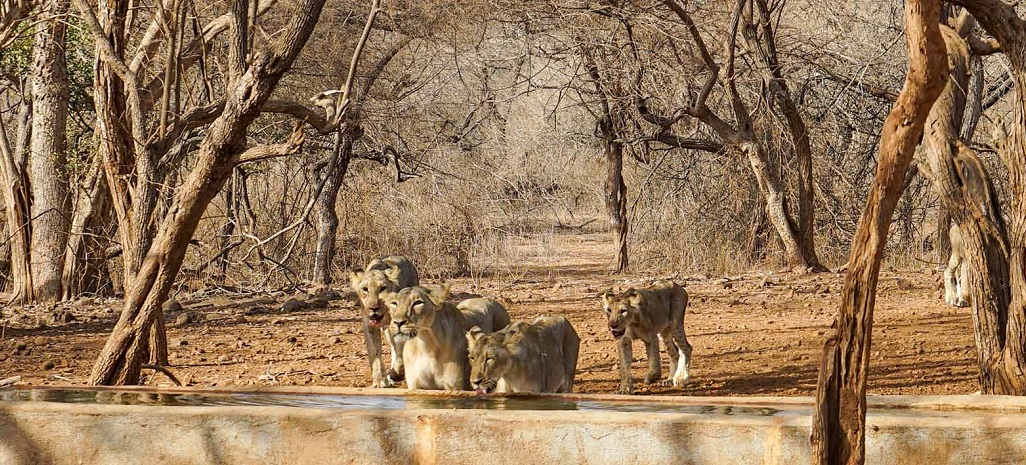Nestled at the southern tip of Gujarat, on the coast of the Arabian Sea, Diu emerges for its harmonious blend of serenity and history. With its roots deeply entrenched in Portuguese heritage, the island served as a prominent trade route in ancient times. Positioned along the tranquil shores of Gujarat's Kathiawar peninsula, Diu presents an idyllic setting for a once-in-a-lifetime getaway. Adventurers can indulge in an array of water sports, including swimming, surfing, and parasailing, while the island's sand-kissed beaches offer a captivating and unparalleled vista, drawing countless tourists annually.
Diu is very often paired with a trip to Sasan Gir National Park. Just 64 km away from the land of roaring lions, Diu is a fantastic location to add a tinge of excitement after the thrilling Jeep Safari in Sasan Gir. Read out to unravel the fun and thrill tangled with the trip to Diu from Gir National Park.
Reaching Gir followed by Diu
To reach Gir National Park, Veraval Junction and Junagadh Junction serve as the nearest railheads. On the other hand, Rajkot International Airport is the only nearest option available if planning to reach by flight. Spending a couple of days at Gir, reach Diu by road, where you have to cover merely 64 km, taking about 2 hours to complete the journey.
Remarkable Landmarks to Visit in Diu
Diu Fort - No visit to Diu is complete without exploring its majestic fortress and formidable architecture perched atop the coastline. Constructed by the Portuguese in the 16th century, this defensive fortress, also known as 'Praça de Diu,' boasts a rich history. Encircled by a moat once inhabited by crocodiles, the Diu Fort showcases a remarkable fusion of European military architecture and Indian artistry. Its intricate stone carvings, imposing walls, and strategically positioned cannons overlooking the Arabian Sea exemplify its grandeur. Climb to the summit of the lighthouse nestled within the fortress to behold a breathtaking panoramic vista encompassing the fort, the sea, and the entire town.
Nagoa Beach - Among Diu's must-visit destinations, Nagoa Beach stands out for its breathtaking scenery, featuring vast stretches of sand dotted with trees and embraced by the gentle waters of the Arabian Sea. Renowned for offering the quintessential beach experience, Nagoa Beach is adorned with rare Hoka Trees, adding to its allure as one of Diu's most captivating sights. Visitors can partake in a myriad of adventure sports, as well as exhilarating camel and pony rides, making it an ideal destination for thrill-seekers and nature enthusiasts alike.
Naida Caves - Located beyond the confines of Diu Fort's city wall lies a cluster of interconnected caves, initially formed naturally and later turned to Portuguese modifications as they extracted rock for construction purposes. This network of tunnels features cleaved steps, inviting visitors to explore and marvel at this natural wonder. Despite being less frequented by tourists, these caves are a hidden gem of Diu and offer an excellent backdrop for photography enthusiasts. With intriguing historical anecdotes adding depth to its allure, this site is sure to captivate the interest of history enthusiasts.
Diu Museum - Originally constructed as St. Thomas Church in 1598, the Diu Museum presently occupies its premises, having been converted into a museum in later years. Within the museum, visitors can marvel at various stone inscriptions commissioned by rulers, along with a collection of 16th-century wooden saints and other sculptures depicting religious figures. Of particular note are the stunning 400-year-old wooden and marble statues portraying St. Thomas and St. Benedict, which stand as captivating testaments to the craftsmanship of bygone eras.
Panikota Fort - Pani Kotha, also known as Fortim Do Mar by the Portuguese, positioned as a fortress amidst the sea, resembling a ship from afar. Despite its maritime appearance, it functioned as a prison during the Portuguese colonial era. Situated on an island in Simbor Bay, approximately 46 km from Diu, Panikota Fort served as a renowned jail, even after India gained independence from Portuguese rule. Its isolated location surrounded by water on all sides made it an ideal incarceration site, ensuring prisoners had no means of escape.
INS Khukri Memorial - The INS Khukri Memorial stands is a tribute to the Indian Naval Ship lost during the Indo-Pak War of 1971. On December 9, 1971, Pakistani torpedo attacks devastated the vessel, ultimately leading to its sinking with 18 officers and 176 sailors aboard. Established in 1999, the memorial honours all the fallen heroes, including Captain Mahendra Nath Mulla, the commanding officer of INS Khukri. It serves as a poignant reminder of the crew's sacrifice, as they opted to go down with the ship rather than surrendering to the enemy, highlighting their unwavering courage and dedication to duty.
Jallandhar Beach - Renowned for its picturesque beauty and tranquil ambiance, Jallandhar Beach offers a serene retreat away from the bustling crowds found at other popular Diu beaches. Named after the nearby Jallandhar Shrine, a small temple honouring a demon defeated by Lord Krishna, the beach exudes a unique charm accentuated by the temple's colourful flags and statues.

